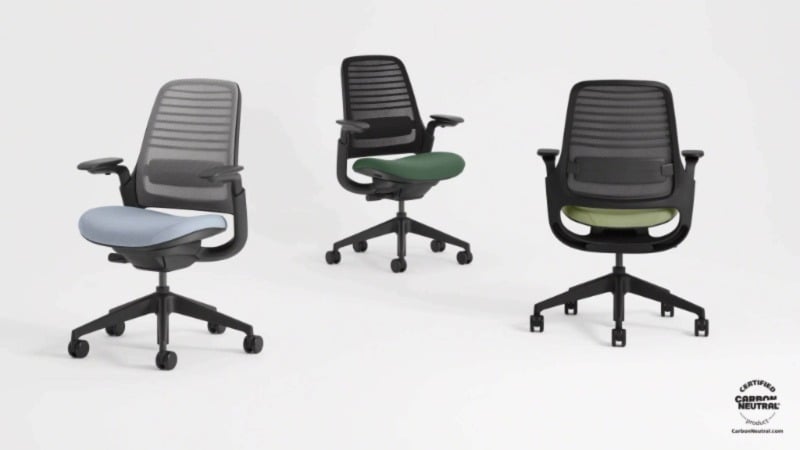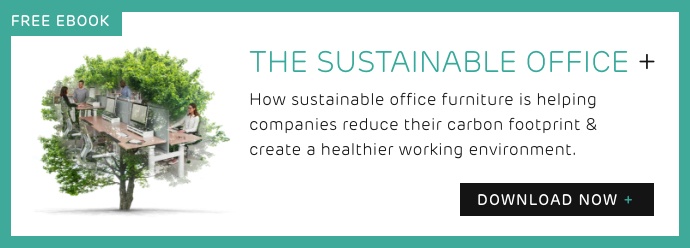In a world facing enormous environmental challenges, one issue looms large on the horizon: waste. From overflowing landfills to the accumulation of discarded materials in our oceans, waste has become an undeniable crisis that demands immediate attention.
As a furniture supplier, we must play our part in waste management and place sustainability at the forefront of our endeavours. That's why we're committed to zero waste to landfill in our operations and in everything we do for our clients.
In this blog post, we delve into the principles guiding our waste management approach and shed light on the strategies we employ to achieve our zero waste target.
Our approach to waste management
We follow the principles of the waste hierarchy model, giving top priority to what we can do to prevent waste in the first place. We have procedures in place to ensure that all of our operational waste is reused, recycled, or recovered through waste-to-energy schemes.
Every product leaves an environmental footprint, from the extraction of raw materials to its production, distribution, use and disposal. The waste hierarchy model provides a roadmap for making smart choices that are both efficient and eco-friendly.
By following this approach, we can make more sustainable decisions and minimise our environmental impact.
We've adapted the model to our processes as follows:

Here we take a closer look at our approach to waste management.
1. Reduce
The waste hierarchy model prioritises preventing waste in the first place.
Klavs Henriksen, Sustainability Manager at IE, says:
"When we supply a product to a customer, there are inevitable side effects. Every product comes with packaging, for example. Companies also often have surplus office furniture that needs to be dealt with. We help our clients to minimise their carbon footprint by reducing the amount of waste produced in the first place."
We reduce the amount of waste produced in several ways:
- By working with suppliers to reduce packaging
We work closely with our suppliers to ensure that packaging contains less material and is recyclable. Any packaging waste is reused or recycled.
- By specifying sustainable furniture options
We help clients choose furniture that will last longer. We specify and offer low-carbon, durable products with longer warranties and highlight the circularity credentials to customers.
- By providing ongoing support
We can provide professional cleaning and regular furniture maintenance to extend product life. We also offer product continuity guarantees, meaning replacement parts will be available for longer. In addition, we can track and store the location, residual value and carbon footprint of assets in a database.
- By providing end-of-life services
When you have furniture you no longer need, we can help find new homes, repurpose it into new products, recycle or ethically dispose of it for you.

2. Reuse
All companies have different requirements for each project. Still, we take a common approach to present options that maximise the reuse of any existing furniture assets first, keeping them within the circular economy where possible.
In other words, the desks and chairs you no longer need could be repurposed into new furniture items for your workplace. Or, they could be resold or donated, giving them a second life elsewhere.
Here are some examples of how we have helped our clients to reduce waste through reuse:
Transforming 500 workstations into smaller desks
We helped one client reduce their furniture waste by transforming 500 unwanted large workstations into smaller versions to fit their new workspace. The workstations were dismantled, and the legs and table tops cut down to fit the new required sizes before being put back together again. Any excess metals and plastics were recycled, and desktop cut-offs reused in waste-to-energy schemes.
The Waste Impact Report is still in progress, however, the current estimate is a saving of over 50% in CO2 emissions by reusing the workstations rather than procuring new ones.
Reusing parts of 100 chairs and recycling the remaining components
For one client, we were able to reuse their chairs aside from the stand and spokes. The remaining parts were sorted and recycled.
Zero waste to landfill through reuse, resale and donations
We helped our client divert an estimated 658 tonnes of CO2 from landfill by reusing, reselling or donating their unwanted office furniture. By donating a portion of their surplus furniture, our client was also able to generate £80,000, split between four charities.
3. Recycle
Of course, some items can't be reused. In this case, the item is returned to our operations centre for recycling. All waste is sorted into categories, including cardboard, paper, plastics and metal, which is then taken away to recycling centres.
Klavs explains how important the process of collecting and sorting materials for recycling is:
"We treat waste as a valuable resource. We treat it respectfully, ensuring that cardboard is kept clean so it's easy to recycle. We're careful to separate paper and plastics and keep different plastics separate. You see, every time we recycle plastics, they lose a bit of their original quality. That's why we take extra care to handle them properly, so they can be transformed into a cleaner material during the recycling process."
4. Recovery
All other operational waste that cannot be recycled is compacted and taken away to be reused in waste-to-energy schemes.
Waste-to-energy serves as a good alternative for managing non-recyclable waste. It involves converting non-recyclable waste materials into usable energy forms, such as heat, electricity, or fuel. Through various processes, the energy content of the waste is harnessed and utilised to power homes, businesses, and even industries.
While waste-to-energy processes do produce emissions, modern technologies and strict regulations minimise their environmental impact. In addition, the energy generated from waste can displace the need for fossil fuels, which reduces greenhouse gas (GHG) emissions associated with traditional energy resources.
5. Disposal
Disposal is the final step in the waste hierarchy model, and it is always the last resort when all other waste management options have been exhausted. At IE, none of our operational waste goes to landfill, and we provide the same commitment when working with our clients.
Summary
IE is committed to applying the waste hierarchy model to our operations and office refurbishments. By prioritising waste prevention, promoting reuse, and implementing recycling and recovery processes, we strive to minimise our environmental impact and achieve zero waste to landfill.
If you'd like to learn more about our ESG commitments, visit our sustainability page. Or, to find out more about working with us, get in touch.











